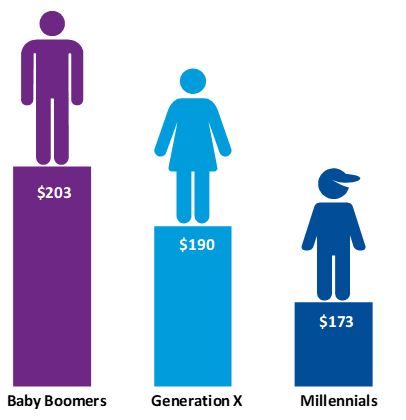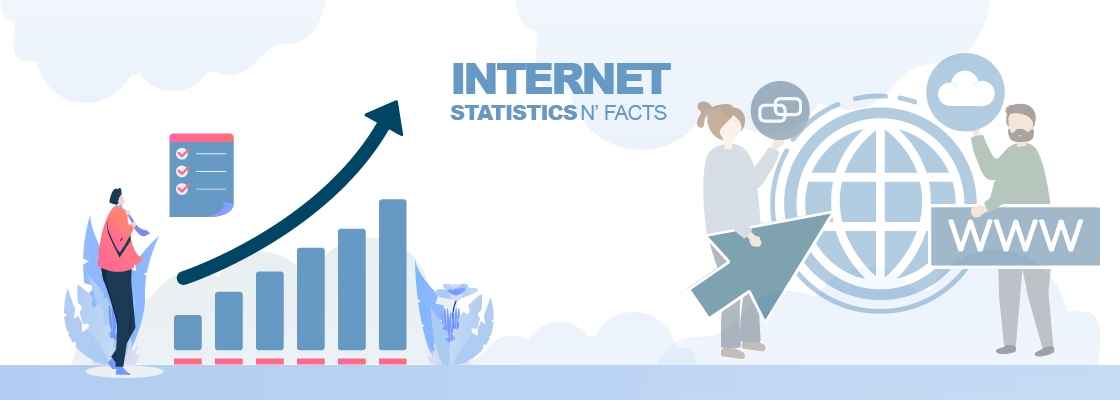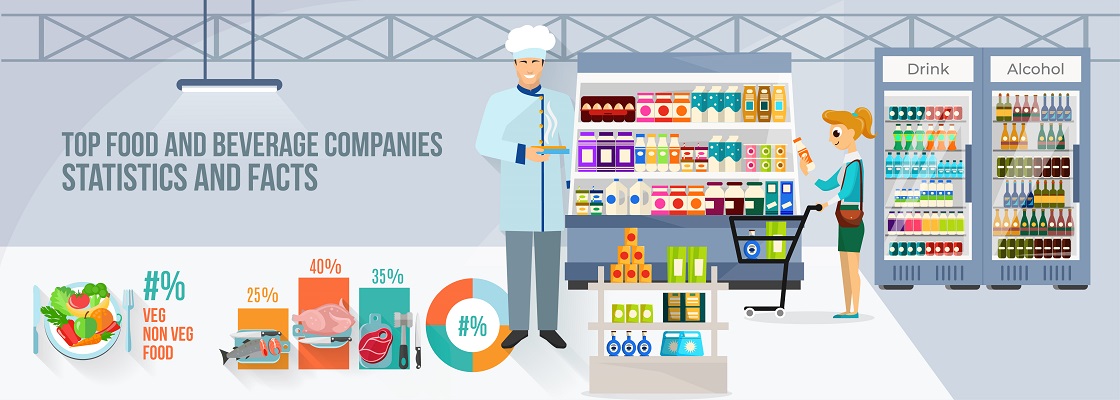Internet Statistics: The Internet is a global system used for sharing information, data, content, marketing, offering services globally, communications, and many more. Sometimes referred to as a “network of networks,” the Internet emerged in the United States with the help of the Advanced Research Projects Agency (ARPA) in the 1970s but did not become visible to the general public until the early 1990s. The Internet supports human communication via electronic mail, newsgroups, and audio and video transmission and allows people to work collaboratively at many different locations, and in real-time. In addition, easily and instantly available daily updates, and the purchase and sale of products and services through the Internet have been steadily paving the way for the constant growth of the target market. The Internet has proved to be a spawning ground for a large and growing number of “e-businesses” that conduct most sales and services over the Internet.
- Increasing popularity and preference for E-commerce websites as various products are offered through this channel at more economic or reasonable prices
- Various online channels share product details, reviews, and conduct promotion activities in order to increase product sales through higher and better visibility, and reach out to a larger potential customer base. Many E-commerce websites are focusing on offering products on EMI and No-cost EMI basis to increase revenue and expand the customer base.
- E-payments help overcome the complicated and extremely costly process of physically collecting cash payments for a product purchased or sold online. According to a report published by the World Bank, formal banking reaches around 40% of the population on average in emerging markets, as compared to the 90% penetration rate for smartphones offering payment options via mobiles (m-payments). This allows easy access to markets and is beneficial to both, consumers and merchants, who would have previously been unable to engage in E-commerce and would not qualify for such services.
- Mobile eCommerce sales are predicted to make up to 63.5% of total eCommerce sales in the year 2019
- Global mobile E-commerce revenue accounted for US$ 669 Billion in 2018
- Out of 10 shoppers, eight Americans shop online, i.e. 51% shop with a smartphone
- By 2020, over 3.3 billion users will have virtual assistance on their devices
- Mobile wallets are expected to surpass both credit and debit purchases by 2020
- In-store mobile payments are expected to reach US$ 503 Billion by 2020
- Digital transactions on Cyber Monday (27 November 2017) reached a record US$ 6.59 Billion, as revealed by Adobe Insights in its final update on the holiday weekend. That marked a 16.8% increase from a year ago and made Monday the largest online shopping day in US history.
- The advent of 5G is expected to bring along new generation technologies that improve the capabilities of mobile networks and support flexibility of approach. These include a new generation air interface based on a new waveform, codec, multiple access technologies, and large-scale antenna arrays, as well as a fully cloud-based network architecture leveraging software-defined network (SDN) and network functions virtualization (NFV).
- 5G technology is expected to provide rapidly expanding potential for new business opportunities for telecom operators, ranging from the provision of Enhanced Mobile Broadband (eMBB) services to the supply of applications to vertical industry customers. In addition, the installation of 5G technology offers lucrative opportunities for players in the market to expand their market presence and revenue share.
As per Cisco, there will be 5.3 billion Internet users by 2023 that is 66% of the total world population will be online
Internet Statistics:
- As of October 2020, there are 4.66 Bn active internet users worldwide.
- 62 percent of the total world population is online
- As of July 2020, on average 6 hrs and 42 minutes of time are spent on the Internet by the users of the age group 16 to 64 every day.
- More users access the Internet with a Chrome browser (64.45%) than any other browser.
- 90% of Internet users access it via a smartphone in 2020.
- The average Internet user spends 6.5 hours online every day.
- For every second of the day, there are 88,555 GB of Internet traffic.
- The average Internet connection speed is 11.03 Mbps.
- South Korea has the fastest Mobile Internet speeds with 113.01 Mbps.
- Libya is the country with the slowest internet in the world.
- AS of 2020, Asia has the largest number of Internet users that 2.525 billion out of total Internet users which makes up to 54.2% of the total Internet users count and 32.4% of the total world population.
- Till May 2020, Europe is the second-largest region to have the most Internet users with 15.7%.
- China has the most Internet users compared to all countries – over 854 million Internet users, and is followed by India with over 560 million Internet users as reported on 31st May 2020.
- North America and Europe both the regions rank first with a 94% and 87% internet penetration rate respectively among the population.
- UAE, Iceland, Norway, Qatar, Bermuda, Andorra, and Aruba have a 99% online usage rate.
- North Korea has only 0.08% online usage penetration among the population, ranking in the last world.
- Asia is the region with the largest number of online users which is over 2 billion.
- Europe ranks second with almost 705 million internet users.
- Kuwait is the country with the highest penetration of Internet users, with 99.6%.
- Global monthly smartphone data traffic was 5.6 gigabytes per active device worldwide in 2018.
- As of March 2019, 73.67% of web page views were from mobile phones in India.
- 73.73% of web traffic.
- Today there are over 2 billion websites out of which less than 400 million are active.
- Internet Ads are about to take more than 50% of the total ad spending by 2021.
- There are 360 million Internet users in the South East Asia region in 2019 and 90% of them connect to the Internet primarily through their mobile phones.
- The Internet economies in Malaysia, Thailand, and Singapore which have 5.17 million internet users, and the Philippines are growing by between 20% and 30% annually.
- According to a survey by Google, the Southeast Asian Internet economy would grow to $200 billion by 2025, by rapid growth in Online Travel, e-Commerce, and Online Media.
- Internet users in Thailand spent 5 hours and 13 minutes per day on the mobile Internet.
- Users from Indonesia, the Philippines, and Malaysia, are connected to the mobile Internet for approximately 4 hours a day and are also among the top 10 countries in the world for mobile Internet usage.
- According to Google, in Indonesia, 46% of all searches for Internet packages come from Non-Metro areas
- The global average mobile Internet usage is 3 hours and 13 minutes a day.
- In the U.S, the digital economy has grown 370% faster than the economy, contributing over $1 trillion per year to America’s GDP.
- In the U.S., smartphone users spend an average of 3 hours 49 minutes on their devices every day.
- It’s estimated that mobile apps will generate $581.9 billion worldwide in 2020.
- There are 366.8 million registered domain names across all top-level domains (TLDs).
- These are the top 3 languages used on websites are English (59.3%), Russian (8.2), and Spanish (4.3%).
- Google holds the majority market share of all search engine activity, with 92.07%.
- on average Google processes, about 80,000 search queries every second.
- It estimates that the Google Search Index contains over 100,000,000 gigabytes of data.
Social Media Platforms:
From 2017 to 2018, the number of active social media users increased by 13%
- YouTube is used by 73% of US adults
- Instagram is used by 35% of US adults
- Pinterest is used by 29% of US adults
- In addition, Snapchat, LinkedIn, Twitter, and WhatsApp are used by 27%, 25%, 24%, and 22% of US adults respectively
Live Status of December 30, 2020:
- Internet users in the world: 4,780,570,145
- Total number of websites: 1,825,371,561
- Emails sent: 192,711,695,734
- Google searches: 5,526,366,208
- Blog posts written: 5,353,283
- Tweets sent: 577,800,128
- Videos viewed on YouTube: 5,708,229,261
- Photos uploaded on Instagram: 64,159,569
- Tumblr posts: 112,413,916
- Facebook active users: 2,659,512,073
- Twitter active users: 368,967,973
- Pinterest active users: 334,408,088
- Skype calls: 326,211,920
- Websites hacked: 128,133
- Computers sold: 490,338
- Smartphones sold: 3,270,979
- Tablets sold: 291,271
- Internet traffic: 6,505,409,753 GB
- Electricity used for Internet: 3,125,486 MWh
- CO2 emissions from Internet: 5,767,159 tons
Summary:

Currently, online shopping is a rapidly growing and expanding trend for shopping and has begun to play an important and essential role in the modern lifestyle. Convenience and ease of use, changing shopping habits, patterns, and preferences, easy payment options, and platforms, and rising demand among customers of all age groups are driving the shift towards online shopping.








